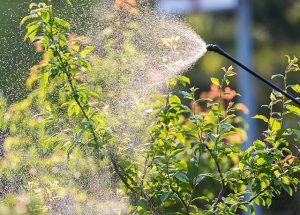
Diazinon – toxicity, side effects, diseases and environmental impacts
Sunday, December 03, 2017 by Earl Garcia
http://www.naturalpedia.com/diazinon-toxicity-side-effects-diseases-and-environmental-impacts.html

An entry featured on the Pesticide Properties DataBase website categorizes diazinon as a synthetic, all-around insecticide. It is used to control and eliminate sucking and chewing insects including bean fly, thrips and caterpillars as well as cabbage white butterfly, loopers, and cutworms.

List of known side effects
An entry published on the Pesticide Action Network North America (PANNA) website reveals that diazinon exposure may cause reproductive and developmental toxicity, neurotoxicity and acute toxicity. According to the entry, the neurotoxicant insecticide primarily targets the respiratory system and triggers the onset of respiratory depression, tightness in chest, and wheezing as well as productive cough and lung fluid accumulation. The chemical may also induce skin irritation and eye disorders.
The harmful chemical may also increase the risk of suffering from headache, dizziness and seizures as well as tremors and loss of consciousness. Likewise, the hazardous compound is associated with general weakness, muscle twitching and reduced muscle coordination. Diazinon exposure is also known to cause vomiting, abdominal cramps, and diarrhea. Additionally, an entry posted on the Extension Toxicology Network website reveals that prolonged contact with the toxic substance has resulted in skeletal and spinal deformities in animal models.
An article posted on the Pub Chem website has also showed that the toxic insecticide may pollute water sources and affect aquatic ecosystems and certain animal species such as fishes, invertebrates and crustaceans. Diazinon is also detrimental to aquatic plants, algae and sediment residing organisms. Likewise, diazinon highly toxic to birds, mammals and other beneficial animals such as honeybees and earthworms.
Body systems affected by diazinon
Diazinon is particularly detrimental to both the respiratory tract and the central nervous system. Likewise, the toxic insecticide may affect the muscles, the bones and the digestive tract. The insecticide may also affect the eyes and the skin.
Items that can contain diazinon
Various trade name insecticides — such as Diazol 60EC, Knox-Out, DZN and Basin as well as Exodin, Nucidol and Diagran — contain diazinon as a primary chemical component. Likewise, diazinon can be traced in other pesticides including pyrethrins, lindane and disulfoton. The chemical is currently sold in Australia and in the U.S.
How to avoid diazinon
A safety data sheet published by the National Institute for Occupational Safety and Health (NIOSH) recommends using protective clothing, gloves and respiratory equipment to reduce the odds of diazinon exposure. The data sheet also suggests that work spaces install adequate ventilation to lower the likelihood of direct chemical contact. In addition, the safety guidelines stress that people exposed to the harmful chemical should contact a poison control center or seek immediate medical help.
Likewise, the data sheet recommends that people exposed to the toxic chemical be taken to an area with fresh air. Victims who had direct eye and skin contact are also advised to remove contaminated clothing articles and contact lenses and thoroughly wash the affected areas with plenty of water. Furthermore, the safety guidelines suggest that people immediately evacuate the area to avoid direct contact if an accidental spill occurs.
Where to learn more
- Illegal pot farms now creating environmental DISASTER with massive runoff of banned pesticides
- Monsanto postpones “NemaStrike” launch after new pesticide causes skin rashes among farmers
- Doctors all across Europe call for glyphosate ban while the U.S. refuses to face the facts
- Study: Women whose partners are pesticide applicators have increased risk of breast, thyroid and ovarian cancer
- AUTONOMOUS PLANES now weaponized as pesticide delivery platforms to inundate farmland with toxic chemicals
- Editor of science journal that forced retraction of Seralini GMO study entered a promotional contract with Monsanto right before smearing the research
Summary
Diazinon causes respiratory depression, productive cough, and lung fluid accumulation.
Diazinon increases the risk of seizures, tremor,s and loss of consciousness.
Diazinon triggers general weakness, muscle twitching, and reduced muscle coordination
Diazinon raises the odds of vomiting, abdominal cramps, and diarrhea.
Diazinon is particularly detrimental to both the respiratory tract and the central nervous system.
Diazinon affects the muscles, the bones and the digestive tract as well as the skin and eyes.
Sources include:
Tagged Under: Tags: diazinon





